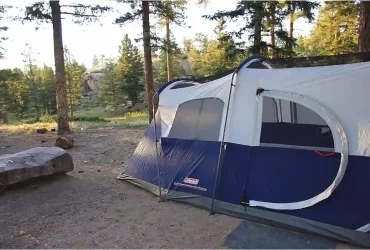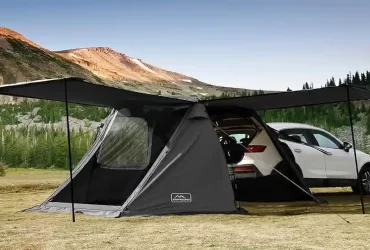The gear necessary for wet conditions has improved dramatically over the past few years, so camping and hiking are no longer a problem for me. The lighter, near-waterproof boots, backpacks, and tents that are now so readily available are easier to use even during downpours.
Preparation is one of the most important factors to consider before camping in rainy weather. Before heading into the backcountry, ensure your gear is in good working order in order to avoid having a weekend from hell. Rain always mutes bubbly conversations as you approach your destination, and happy chatter invariably turns into groans. Yet, setting up a tent in the rain is no problem.
Also like this:
Setting up a Tent in the Rain: What you Need to Know

Selecting a suitable tent
Pop-up tents, double-wall tents, and canvas tents are suitable tent types during heavy rain. Double-layer tents are highly versatile and can be used in numerous weather conditions. Protect yourself from the elements with rainflies that are separate from the tent. A fast-pitch tent or pop-up tent can be assembled in seconds, and it’s easy to go under a shelter.
Shelter the area
The process of setting up a tent in the rain involves being aware of how to do it and establishing a sheltered area ahead of time. This is one way to achieve the purpose of a camping tarp. A lightweight tarp that is easy to handle and durable is the best choice. Ensure that it is large enough to provide adequate shelter.
In order to set up a tent as quickly as possible, we first set up a tarp. The easiest way to accomplish this is to run a single guy line between two trees at the height that works for you. The guy lines should be tied around the corners of the tarp next. Be sure to skateboard the tarp with its edges lower than its center. Flowing water downward will be made easier if this is done. It is spacious outside the tent so you can rest under the tarp. Additionally, the tarp provides a good place to dry your stuff.
Tent pitch
As long as your gear and shelter remain dry throughout the night, you should be fine. If the shelter is in your pack, remove it carefully so that the rest of your kit is not exposed to the rain. The only time your tent will have a problem staying dry is if you pitch it inner-first. Due to this, you need to prepare your tent as soon as possible. Rain should be kept away from the tent by throwing the flysheet over it.
Get under cover
Before you go inside the tent, be sure to do any outside chores, such as filling your water containers, before you go inside the tent to avoid wetting the groundsheet. It is best to place your pack in the porch of the tent and crouch next to it while you strip off your wet waterproofs and clothing. Wearing wet clothing should not be done on the groundsheet.
Stay dry
Sit on your sleeping mat and put on some warm clothes once you’ve reached the tent. Any items that are wet should not be brought into the tent. Ensure that the tent has adequate ventilation to allow air to pass through without letting the rain in. You will be able to reduce condensation this way.
Avoid going outside again whenever possible, but if you must, be sure to tighten peg points and guylines because nylon stretches and sags when wet. When pegs begin to pull away from damp ground, you may need to stamp them.
Footprint of tent to use
When the tent floor gets muddy, how does it hold the water? The tent’s floor can also become damaged by debris on the muddy surface. This is why it is imperative to maintain a separate tent footprint. This layer of protection will provide additional protection during rainy weather. Cleaning the tent’s floor will be more difficult than cleaning its footprint because sticky mud will stick to it.
The tent footprint should be spaced two to three inches from the tent’s outside edge. There will be no water collection between the tent’s footprint and the floor. If the water is not handled properly, leaks and condensation can occur.
How can a rainfly make camping more enjoyable?
In addition to the main tent, a rain fly tent can provide additional protection. When added to your clothing, you can stay safer from the elements, even in hotter weather. There are many ways to attach a rain fly to a tent, and sometimes they’re colored to make it easier to see where each end goes. After staking down the rain fly, it is a good idea to make sure it stays in place.
The importance of heavy and windy rain cannot be overstated. It is possible for water to pool beneath a rain fly if it is not secured properly, seep into the tent, and contaminate your gear, clothing, and sleeping bags. For rainy days, tents with porch vestibules are also useful. A tent’s outside sleeping area is ideal for placing wet boots, cooking equipment, etc. Rainflies can also be used as rain protection for the porch vestibule.
Also like this:
Is it necessary to waterproof a good tent?
It doesn’t matter how much I use my tent, I always waterproof tent every two years, regardless of how much people insist it needn’t be waterproofed. In spite of the fact that it isn’t strictly necessary, doing this gives me a great deal of peace of mind.





Leave a Reply
View Comments